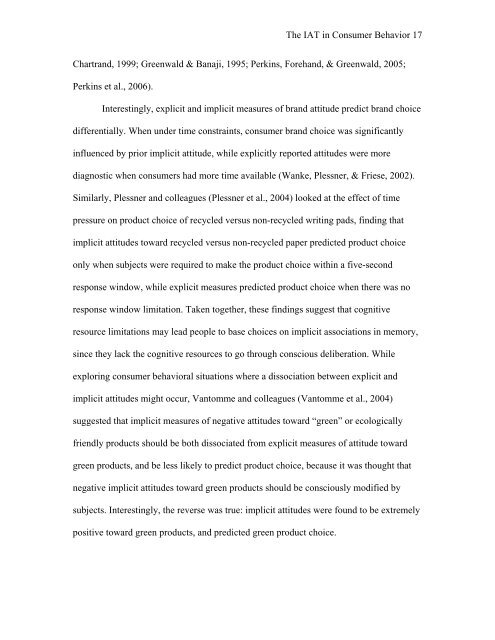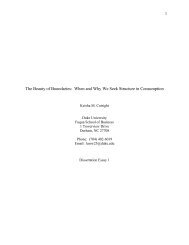RUNNING HEAD: The IAT in Consumer Behavior - Wharton Marketing
RUNNING HEAD: The IAT in Consumer Behavior - Wharton Marketing
RUNNING HEAD: The IAT in Consumer Behavior - Wharton Marketing
Create successful ePaper yourself
Turn your PDF publications into a flip-book with our unique Google optimized e-Paper software.
<strong>The</strong> <strong>IAT</strong> <strong>in</strong> <strong>Consumer</strong> <strong>Behavior</strong> 17Chartrand, 1999; Greenwald & Banaji, 1995; Perk<strong>in</strong>s, Forehand, & Greenwald, 2005;Perk<strong>in</strong>s et al., 2006).Interest<strong>in</strong>gly, explicit and implicit measures of brand attitude predict brand choicedifferentially. When under time constra<strong>in</strong>ts, consumer brand choice was significantly<strong>in</strong>fluenced by prior implicit attitude, while explicitly reported attitudes were morediagnostic when consumers had more time available (Wanke, Plessner, & Friese, 2002).Similarly, Plessner and colleagues (Plessner et al., 2004) looked at the effect of timepressure on product choice of recycled versus non-recycled writ<strong>in</strong>g pads, f<strong>in</strong>d<strong>in</strong>g thatimplicit attitudes toward recycled versus non-recycled paper predicted product choiceonly when subjects were required to make the product choice with<strong>in</strong> a five-secondresponse w<strong>in</strong>dow, while explicit measures predicted product choice when there was noresponse w<strong>in</strong>dow limitation. Taken together, these f<strong>in</strong>d<strong>in</strong>gs suggest that cognitiveresource limitations may lead people to base choices on implicit associations <strong>in</strong> memory,s<strong>in</strong>ce they lack the cognitive resources to go through conscious deliberation. Whileexplor<strong>in</strong>g consumer behavioral situations where a dissociation between explicit andimplicit attitudes might occur, Vantomme and colleagues (Vantomme et al., 2004)suggested that implicit measures of negative attitudes toward “green” or ecologicallyfriendly products should be both dissociated from explicit measures of attitude towardgreen products, and be less likely to predict product choice, because it was thought thatnegative implicit attitudes toward green products should be consciously modified bysubjects. Interest<strong>in</strong>gly, the reverse was true: implicit attitudes were found to be extremelypositive toward green products, and predicted green product choice.




